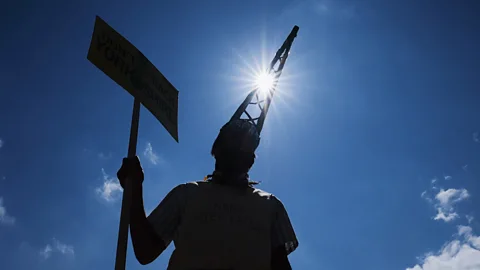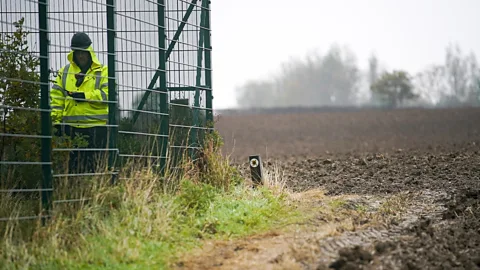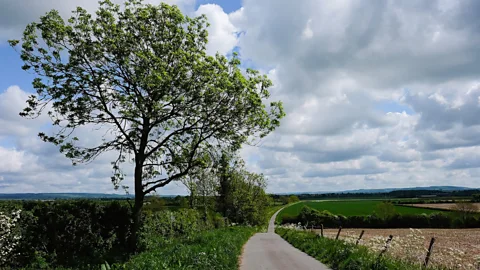The former fracking site now tapped for clean geothermal heat
 Getty Images
Getty ImagesSeveral old fossil fuel wells in the north of England – including one that runs 3km deep – were going to be used for fracking. Instead, they may be a template for the UK's geothermal industry.
As the police moved in, Mike Potter gritted his teeth. It seemed to him that he and his fellow protesters were being "kettled" – surrounded by police and constrained from moving. "No fracking here!", the demonstrators chanted, gripping their colourful placards.
Fracking, the process of injecting fluid deep into subterranean rock to force out natural gas, emerged during the US Civil War in the 1860s and was first used commercially in the late 1940s. By the 1970s, it had arrived in the UK; over the next 30 years, around 200 gas wells were fracked across the country. But, aside from the question of contributing to further carbon emissions, fracking is potentially dangerous, as it can sometimes trigger earthquakes or contaminate groundwater.
In 2016, the prospect of it came to the tiny village of Kirby Misperton in the north of England, close to Potter's home. That year, a local council granted the energy firm Third Energy planning permission to begin fracking at the site.
"I thought, until all these people, governments and companies, can actually prove to me that they can and will do this safely," recalls Potter, "I'm going to be anti-fracking."
It was a risk. He had a government job with security clearance – if police arrested him, it could have been highly damaging to his career. In the end, widespread opposition to fracking led to the UK government banning the practice in England in 2019.
Potter and his fellow protestors were relieved. But questions remained – namely, what was going to happen to the would-be fracking site, a roughly rectangular patch of ground packed with industrial equipment and surrounded by North Yorkshire fields?
For years, deep boreholes had yielded gas here, but that gas is now depleted. (And this explains Third Energy’s previous attempts to repurpose the wells for fracking, to squeeze some more gas out of the site.) Now, the firm, acquired in 2024 by renewables company CeraPhi Energy, says it has a new and very different idea: geothermal energy.
 Getty Images
Getty ImagesAround the world, many different forms of geothermal energy are in use. Iceland, for instance, gains a significant portion of its heating needs from geothermal. Its engineers have long worked on a project to tap into the searing heat of an underground volcano to generate electricity.
But geothermal potential also lies in less geologically active places. And old oil wells, sometimes multiple kilometres deep, can reach underground regions that are naturally warm. The deeper you go, the hotter the rocks tend to be.
In the approach proposed by Third Energy, known as closed-loop geothermal, a sealed, water-filled loop is sunk deep inside former oil or gas wells to absorb the naturally occurring heat at their bases. The warmed water in the loop then returns to the surface. In this way, the heat can be ed to nearby buildings.
Unlike fracking, there is no forcing of fluid into the adjacent rock. "You're not touching the geology at all," says Russell Hoare, managing director at Third Energy. "You're just putting a small tube on the inside of the well."
The deepest well at Kirby Misperton, dubbed KM8, descends for 3km (1.9 miles). In tests, the temperature at the well's base was even hotter than Third Energy expected – around 115C (240F), rather than the anticipated 90C (190F) or so. Early experiments by Third Energy suggested that the system could maintain a steady temperature of around 42C (108F) at the surface. Heat pumps would boost this heat supply further, if necessary, before ing it on to local homes.
"That well, if it was configured properly, could probably provide enough heat for 100 homes," says Hoare.
Hoare also says that Third Energy has a total of 12 wells it could use for geothermal energy in Yorkshire, three of them at Kirby Misperton. "What this gives me is potentially another 25-plus years' life out of those wells," he adds, explaining that the firm is keen to drill additional wells locally to expand their future network of geothermal boreholes, if possible.
 Getty Images
Getty ImagesThe process isn't cheap. Even for a well half the depth of KM8, it could cost up to £1m ($1.3m) to drill and fit it with the water loop equipment. But there's a big potential pay-off, says Hoare: the wells might provide heat for many years, practically without interruption, so long as the resource is maintained by occasionally topping up the underground heat. This could be achieved by periodically sending hot water down the loop within the well to raise the temperature of the geology below.
Former protestors like Potter scrutinised Third Energy's proposals. Many were initially sceptical of the plans. But after witnessing a demonstration of how the system might work, Potter says, "I was absolutely blown away." He now volunteers on behalf of Third Energy and has canvassed local organisations and businesses, from schools to a nearby swimming pool, to find out how much heat energy they need and whether they might be able to make use of a future geothermal supply.
Fellow former protestor and local resident Hazel Winter, a teaching assistant, is also gung-ho for the new idea. "It's all for the good, it's a complete turnaround," adds Winter. "It helps them keep fossil fuels in the ground and it could be the template for a whole new industry."
Potter recalls marvelling at the system – heat drawn out of the ground and yet no disruption to the rock or soil below. "I was looking at this thinking, 'This is just too good to be true – what's the catch">window._taboola = window._taboola || []; _taboola.push({ mode: 'alternating-thumbnails-a', container: 'taboola-below-article', placement: 'Below Article', target_type: 'mix' });
